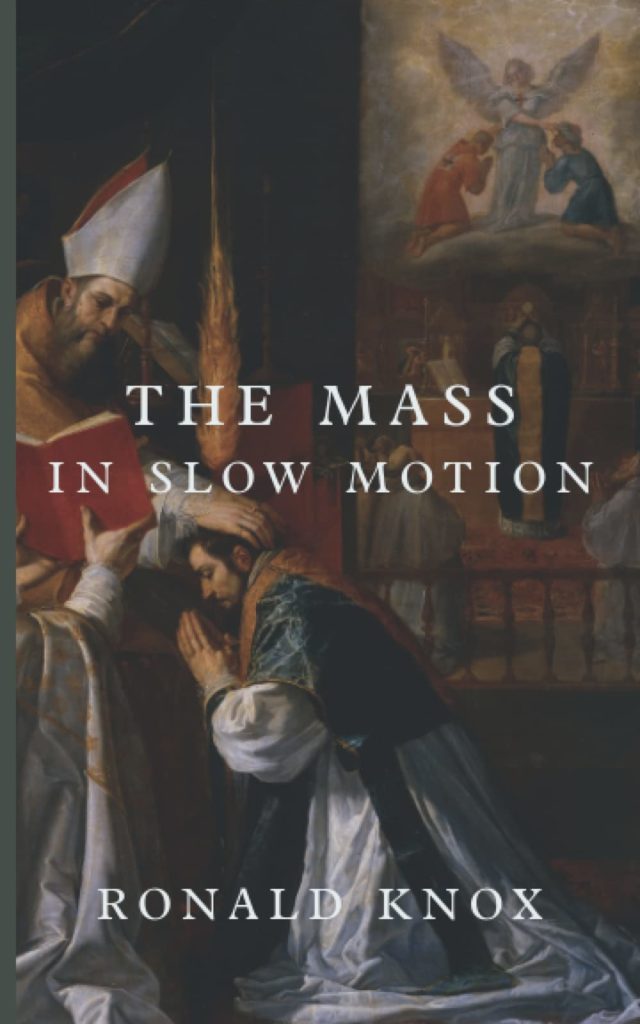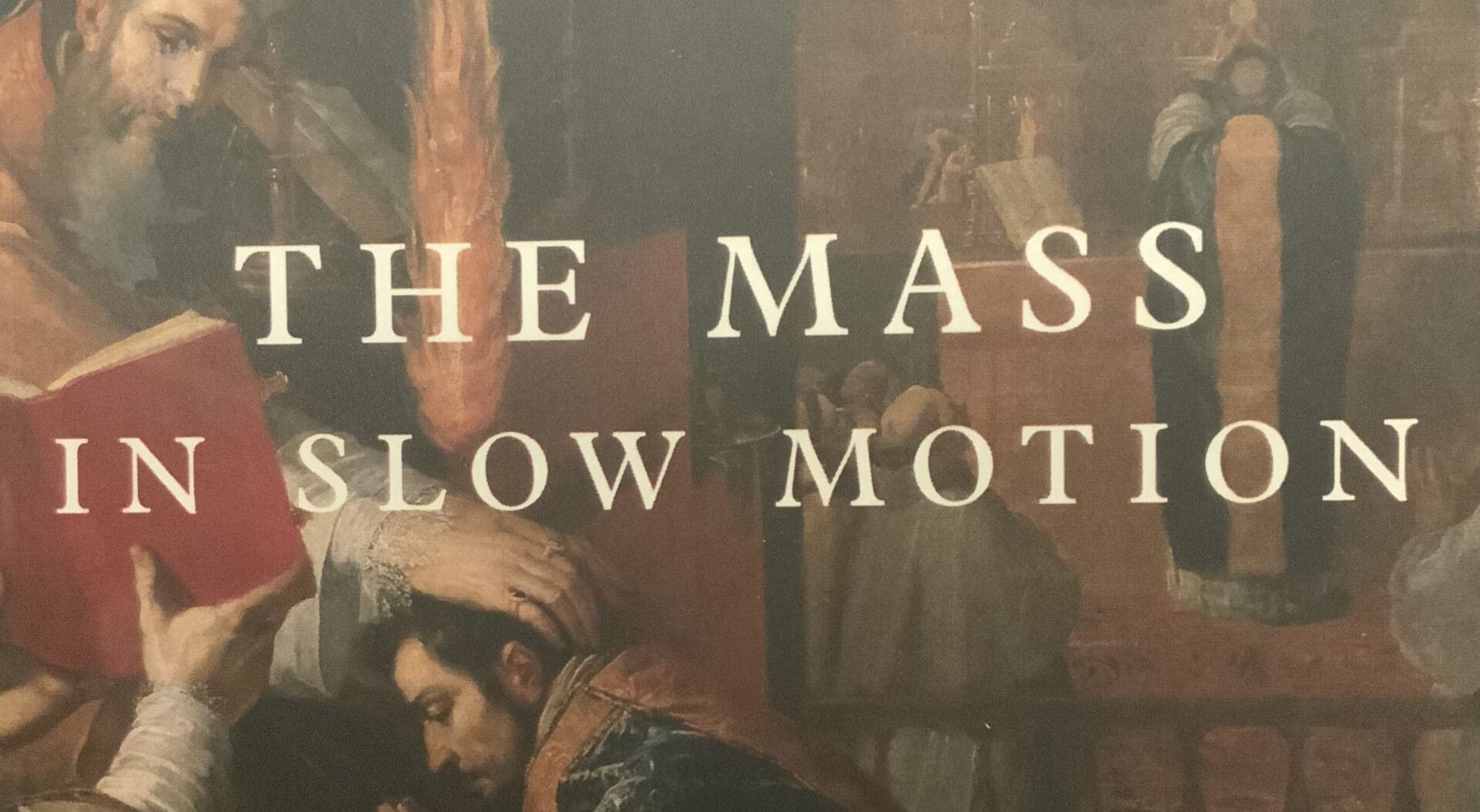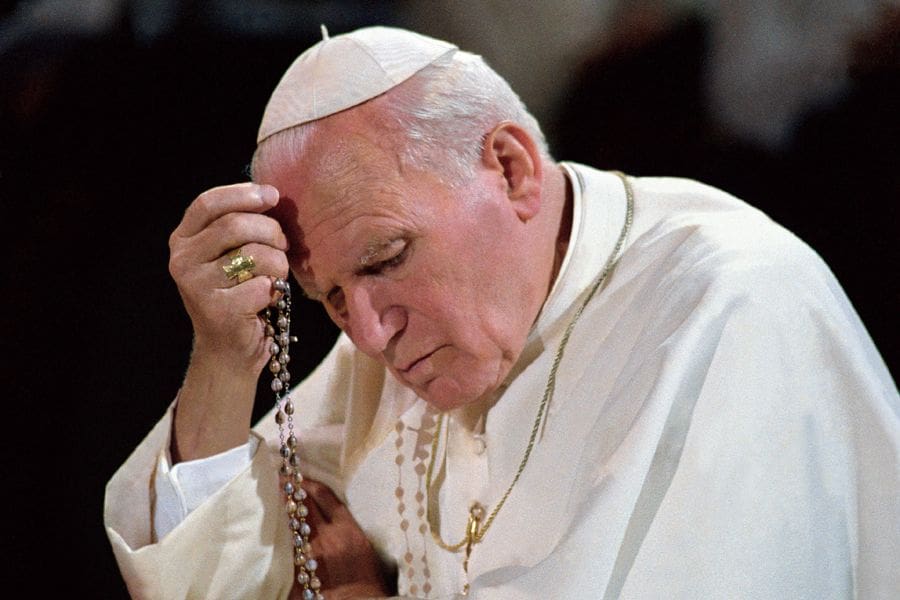The Mass in Slow Motion by Ronald Knox. Providence, Rhode Island: Cluny Media, 2022. 130 pp. ISBN: 978-1685950736 $19.95 paperback; $12.95 digital.
Cluny Media has republished one of the more incisive books by the legendary English convert and apologist for the Catholic faith, Father Ronald Knox. This book, The Mass in Slow Motion (originally published in 1948), is a series of sermons given to a group of young women attending the convent school of the Assumption Sisters in Aldenham Park, England. (The Mass in Slow Motion is also the first of Fr. Knox’s “Slow Motion” series, which includes The Creed in Slow Motion (1949) and The Gospel in Slow Motion (1950).) Because of the relatively young age of his audience, the language of the book is not very sophisticated but is still readable and enjoyable for an older audience. These reflections on the Tridentine Mass (the only form of the Mass available at the time Father Knox was writing) are personal reflections rather than a strictly liturgical explanation of what each part of the Mass means and represents. He states at the beginning and throughout the book that he is not an expert in the liturgy nor does he pretend to be one.

Father Knox was originally an Anglican and converted to the Catholic faith in 1917. His conversion was in part due to the “Apostle of Common Sense,” G. K. Chesterton, who was himself an Anglican at the time. After converting to the Catholic faith, Knox was ordained to the priesthood in 1918. Chesterton would convert in 1922 and attributed it in part to Father Knox’s initial conversion. He was a chaplain at Oxford University from 1926-1939. He died of terminal cancer in 1957. Father Knox is largely known for translating the Vulgate into a beautiful English edition, apologetical writings, and detective fiction.
Throughout The Mass in Slow Motion, Father Knox makes numerous comical references to the little things that sometimes take place at Mass: someone sitting in your favorite pew; the altar server not knowing what exactly he is to do; and Father Knox himself trying to chant the Ite, missa est at the end of a High Mass. Father Knox’s approach is similar to that of Venerable Fulton J. Sheen—like this other great Catholic evangelist, Father Knox uses humor to lighten the mood before delving into a deeper theological issue or topic.
One of the key elements running through the book is Knox’s view that the Mass is a type of “dance.” This idea originally came from Father Robert Hugh Benson’s book, Papers of a Pariah (1907). (Father Benson is another well-known Catholic convert and powerful apologist for the faith.) Father Knox clarifies, however, that this dance is not the typical dance we think of: “Of course that sounds like nonsense to you, because what you mean by a dance is the wireless in the hall playing revolting stuff and you lounging around in pairs and feeling all gooey. But dancing when it first started meant something and nearly always something religious.” He explains that all the actions at Mass (some of which may seem strange) are actually expressing a religious idea to the onlookers.
Insight in Sight
Father Knox begins his study of the Mass by focusing on the introductory Psalm 42, Judica me Deus. He believes that the introductory psalm is about a Levite—a priest of the Jewish Temple—who was unjustly accused of a crime and banished. In the end, Father Knox concludes, the priest is justified by God who knows the truth of the matter. Once the priest is exonerated, he returns to his country to minister to his people. This historical background helps us understand why this psalm is a particularly fitting prayer for the priest to recite as he begins Mass.
Father Knox proceeds to examine many of the different parts of the liturgy, including the Introit, Gloria, Creed, Collects, Offertory, the Secret prayer, and more. Of particular note is his analysis of the moment the priest kisses the altar. Here, according to Father Knox, the priest is venerating the relics of saints placed within the altar stone. The author explains that this veneration of the relics calls to mind the early Christians celebrating Mass in the catacombs on the tombs of saints and martyrs. Father Knox writes that many think this practice is even mentioned in the book of Revelation when St. John describes how “When [the Lamb] broke open the fifth seal, I saw underneath the altar the souls of those who had been slaughtered because of the witness they bore to the word of God” (6:9).
In his introductory remarks about the Mass, Father Knox reminds us that the Mass is not merely a series of words prayed but is a series of words and actions: “the Mass is actions as well as words, in fact the whole time it is suiting the actions to the words.” Because humans are body-soul composites, the Mass is a composite of actions and prayers as well. Problems arise, however, when we fail to recognize this composite in a balanced way. Modernism, for instance, denies the spiritual aspect of man, while those with an erroneous sense of piety may see the body as “dirty” or “unworthy,” denying the physical aspect of humanity. But we know, since God, after creating the physical world, called it “good,” that all of creation is good. This truth is also underscored by the liturgy itself. For, in the liturgy, God takes matter—bread, wine, incense, mosaics, and the stone and wood that make up a church—and transforms them into something spiritual, even while retaining their physical qualities. Bread and wine are transubstantiated into the Body and Blood of Jesus Christ while retaining the accidents of bread and wine. Wood, stones, and other materials are made into the church building representing the Heavenly Jerusalem here on earth. In this way, all of creation gives praise to God through the liturgy.
Priestly Users Guide
Father Knox’s reflections on the Mass are particularly pertinent for priests. He explains the immense sense of unworthiness that the priest feels at different moments of the Mass, noting that he is but an instrument of Christ, an instrument of the Church. As Knox says in his introduction: “He must think of himself as an inconsiderable unit of this great army whose whole cause now, all the multitudinous needs of the Church of God, he proceeds to recommend to God….” Continuing, he also states that often Holy Communion can seem like an interruption for the priest, but he points out its significance: “As for the Communion of the Faithful—at least if there are many—how difficult it is not to feel this as an interruption in ‘my Mass’! But of course there is no such thing as ‘my Mass’; we are ministers before we are priests, and it is for us to wait (hours, if need be) on our ministering.” During Mass and indeed all the celebrations of the sacraments, the priest acts in persona Christi. Regardless of how unworthy the priest may be, he can celebrate the sacraments by the fact of his ordination.
Another point that Knox emphasizes is that the Mass is a corporate action of the people and the priest. During offertory, the people present to the priest the wine and bread for consecration as their gifts to the Church. The priest then takes the prayers of the people and their gifts and presents them to God. Although he does not explicitly say it, Knox is here referring to the people’s active participation (mainly their interior participation) in the sacred liturgy. Knox makes it a point to say that the congregation should not only bring to God those things that are bad but also those things that are good. He says that Catholics so often speak of “offering up” pains and sufferings but never think to offer up their joys and blessings as well. This makes perfect sense considering that the Mass is a Eucharistic sacrifice. The Greek word transliterated to eucharist literally means a “thank offering” which stems from the thank offerings of the Old Testament. To fill out the picture of this “thank offering,” Father Knox uses the typical example of the people placing all their prayers and offerings on the priest’s paten to be united with his offering.
While discussing this aspect of the liturgy, Father Knox makes an important distinction between what takes place during Mass and during Benediction. He writes, “What you come to Mass for isn’t to worship Jesus Christ present in the Sacrament of the Altar; that isn’t Mass, that’s Benediction. You come to Mass to offer Jesus Christ with the priest, and to offer yourself to God with Jesus Christ and as a part of Jesus Christ.” While Eucharistic adoration is an important complement to the sacred liturgy, it is not the primary expression of worship in the Church. The primary expression is found in Mass, the re-presenting of the sacrifice that Christ made of himself on Calvary, which we take part in at Mass.
Throughout his reflections, Father Knox mentions how many of the prayers of the liturgy, especially the Psalms, often speak of the righteousness of the people of God. Upon further reflection, however, he states that all the people of God are in fact sinners. Put simply, we are all unworthy to receive our Lord in Holy Communion. We are not as righteous as the prayers claim we should be. Father Knox mentions that he himself is a sinner as indeed all men are sinners (See Romans 3:9-12)—if we are being honest with ourselves and others. Father Knox explains that God makes us worthy by his grace to receive him. We have no right to receive him, but because of Christ’s redemptive Passion, death, and resurrection, we can and do.
Mass Made Simple
The favorite part of the Mass for Father Knox is the “Our Father.” Being a gifted translator, he explains that when Jesus taught his disciples to pray the “Our Father” and mentions how the heathens pray, the original Greek is often translated into English as “vain repetitions.” Father Knox says that this may seem strange considering that Catholics pray the “Our Father” numerous times a day. Even priests and religious usually pray the “Our Father” at least three times a day (Morning Prayer, Mass, and Evening Prayer).
But Father Knox offers a different translation. He sees the Greek saying, “Do not use many Phrases.” In his explanation of this alternative translation, he writes “I think it’s a warning against saying complicated sort of prayers and expecting them to be effective because they are complicated, which is what the heathen did.” The pagans would often use sophisticated language thinking it would gain more favor with their deities. For Father Knox, the “Our Father” is the best prayer to be said because it asks for everything that a man needs and asks for God’s protection from evil and temptations without using long and wordy phrases.
Father Knox emphasizes the importance of active participation in the liturgy in a number of ways. He greatly encourages the reader to use pew missals with English translations of the Mass parts. He even says that he wished certain parts of the Low Mass were done out loud so that people could hear the beautiful prayers. The sermons he presents are mainly to help the reader delve deeper into understanding the Mass and to better participate in it. He critiques those who say devotional prayers throughout Mass and says that his sermons are “for those who like to follow the liturgy.” In other words, he is speaking to those who actively participate at Mass—or want to. In these observations, Father Knox appears to be adopting the perspective of the great Liturgical Movement thinkers, for whom a true understanding of active participation at Mass was a kind of first principle of their approach to the liturgy.
Likewise, more than two decades after Father Knox was writing, the Second Vatican Council’s document on the liturgy, Sacrosanctum Concilium, emphasized the importance of active participation in the liturgy: “Mother Church earnestly desires that all the faithful should be led to that fully conscious, and active participation in liturgical celebrations which is demanded by the very nature of the liturgy. Such participation by the Christian people as ‘a chosen race, a royal priesthood, a holy nation, a redeemed people’ (1 Peter 2:9; cf. 2:4-5), is their right and duty by reason of their baptism” (14). The fruitfulness of the grace one receives at Mass is conditioned upon the degree to which one is actively and consciously participating in the Mass. Father Knox’s The Mass in Slow Motion can greatly help in the active participation of the Mass, in either its preconciliar or postconciliar forms.
In addition, this book is an important aid to help those who know little to nothing about the preconciliar form of the Mass and are looking for a primer on the subject. Father Knox gives the reader a window into the celebration of the preconciliar Mass without getting into the technical liturgical language common to textbooks. For this reason, the book is a good read for younger audiences—which shouldn’t be a surprise since it was a young audience that he addressed these sermons to in the first place. Of course, many of the principles laid forth by Father Knox pertain equally to both forms of the Roman Rite. While both celebrations vary to some degree, the theology of the Mass presented by Father Knox is the same. Overall, The Mass in Slow Motion is a brief and enjoyable read on the Mass.
Joseph Tuttle is a Catholic freelance writer and author. His work has appeared in or is forthcoming from Word on Fire Blog, The St. Austin Review, New Oxford Review, The University Bookman, and Aleteia among others. He is the author of An Hour with Archbishop Fulton J. Sheen (Liguori, 2021) and a contributing author/editor of Tolkien and Faith: Essays on Christian Truth in Middle Earth (Voyage Comics, 2021). He graduated cum laude with a B.A. in Theology from Benedictine College.


